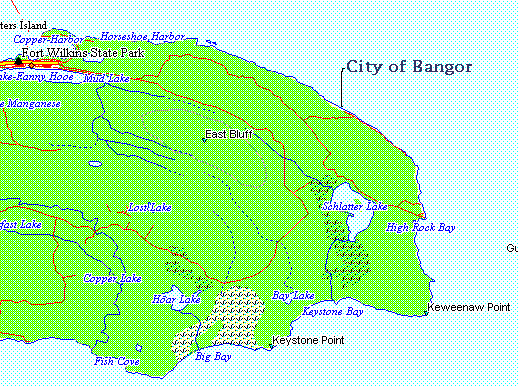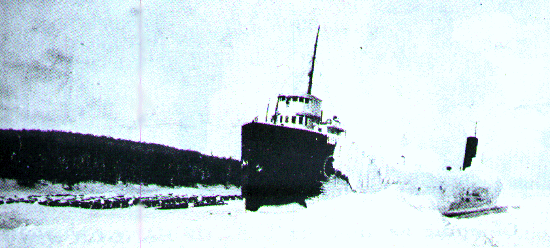
Type: Steel Steamer Length: 444.5 ft. x 44.8 ft. x 23.5 ft., 3690 gt. Depth: 10 - 15 ft. Location: 2 mi. West of Keweenaw Point LORAN: 31703.1/46680.7 LON/LAT: 47.27'37"/87.44'76"
On the evening of November 30, 1926, the steel steamer City of Bangor was upbound from Detroit with a load of Chrysler and Whippet automobiles for Duluth when she encountered a heavy gale and snowstorm just off Eagle River. Captain W.J. Mackin decided to run for the lee side of the Keweenaw Peninsula and shelter, but just short of the point the Bangor's steam steering apparatus failed and she fell into the trough of the waves. The seas which had been sweeping green water over the Bangor's decks kept the crew isolated fore and aft for some 24 hours, finally jettisoning 18 of her deckload of Chryslers before the Bangor washed up broadside on the rocky shore about 2 miles West of Keweenaw Point at 6:10 PM on November 30th. The pounding waves quickly breached the Bangor's hull and the freezing lake water soon extinguished her engines, leaving the vessel freezing cold.
Clad in light clothing, the crew was forced ashore where they built bonfires in the woods, while those with better clothing set out for Copper Harbor along the snowdrifted and rocky shore. The men in the woods nearly succumbed, with the ships' officers having to forceably keep them moving. Fortunately, the Eagle Harbor Lifesaving crew had been called out to rescue the crew of the Thomas Maytham which had stranded at Bete Grise. On their way back, they spotted the freezing crew of the Bangor and returned that evening to pick them up. Most of the crew were suffering from exposure and frostbite and were eventually taken to Calumet for hospitalization.

Today, only incidental remains litter the wrecksite. They are intermixed with the remains of the Altadoc which wrecked only 1000 ft. to the East in 1927. There are some rusty remains of salvage operations on the shore and many large mushroom shaped rivets litter the rocky bottom. A very rough trail leads approximately to the site, but divers should consider getting a local guide, since the backwoods trails can be very confusing and are poorly mapped. The site can be dove from shore and is about two miles West of the Scotia wrecksite which can be visited on the same trip. This site is shallow and is best dived in calm conditions.
